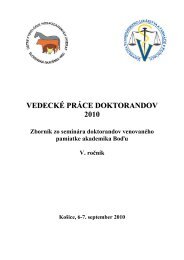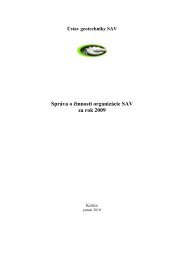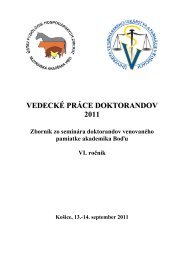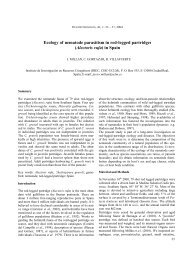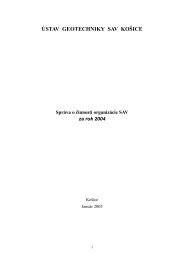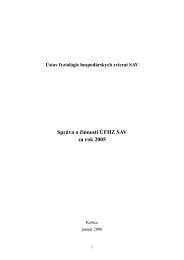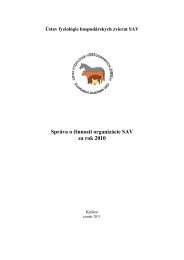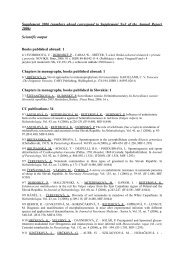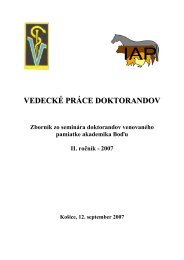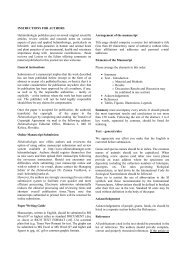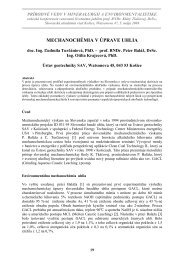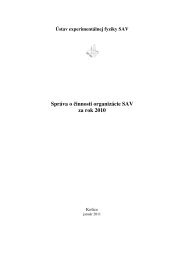Troglotrema acutum (Digenea) from carnivores in the Czech Republic
Troglotrema acutum (Digenea) from carnivores in the Czech Republic
Troglotrema acutum (Digenea) from carnivores in the Czech Republic
You also want an ePaper? Increase the reach of your titles
YUMPU automatically turns print PDFs into web optimized ePapers that Google loves.
Species<br />
Table 1. Survey of <strong>the</strong> exam<strong>in</strong>ed species of <strong>carnivores</strong> <strong>in</strong> <strong>the</strong> <strong>Czech</strong> <strong>Republic</strong><br />
NM Prague MM Brno SM Opava IVB CzAS Total<br />
n Positive n Positive n Positive n Positive n Positive<br />
Mustelidae<br />
M.nivalis 141 0 68 0 699 0 346 0 1254 0<br />
M. erm<strong>in</strong>ea 59 0 64 0 99 0 102 0 324 0<br />
M. putorius 189 2 232 20 189 38 547 22 1157 82<br />
M. eversmannii 21 0 29 0 5 0 14 0 69 0<br />
M. martes 67 1 128 1 72 2 175 3 442 7<br />
M. fo<strong>in</strong>a 139 1 153 2 177 0 243 1 712 4<br />
M. vison 14 0 18 0 24 0 56 0<br />
L. lutra 86 0 11 0 4 0 10 1 111 1<br />
M. meles 100 0 37 0 16 0 31 2 184 2<br />
Felidae<br />
L. lynx 75* 0 75 0<br />
F. silvestris 1 0 1 0<br />
Canidae<br />
V. vulpes 189 2 246 2 96 1<br />
N.procyonoides 2 0 7 0<br />
Procyonidae<br />
P. lotor 2 0 2 0<br />
Total 1007 6 986 25 1364 41 1927 35 5282 101<br />
NM Prague – National Museum Prague; MM Brno – Moravian Museum Brno; SM Opava – Silesian Museum, Opava; IVB, CzAS – Institute of<br />
Vertebrate Biology CzAS, Brno; * – �ervený and Koubek (2000)<br />
todes <strong>in</strong> 5 282 skulls of <strong>carnivores</strong> (11 autochthonous species<br />
and 3 allochthonous species) <strong>from</strong> <strong>Czech</strong> <strong>Republic</strong><br />
were evaluated. The studied skulls were collected over a<br />
relatively long period (1949-2002) and were obta<strong>in</strong>ed <strong>from</strong><br />
four skull collections <strong>in</strong> <strong>the</strong> <strong>Czech</strong> scientific <strong>in</strong>stitutions:<br />
National Museum, Prague, Moravian Museum, Brno, Silesian<br />
Museum, Opava and Institute of Vertebrate Biology<br />
CzAS, Brno. This skull material was prepared <strong>in</strong> a standard<br />
way as dried museum material. Apart <strong>from</strong> <strong>the</strong> dry material,<br />
we also exam<strong>in</strong>ed 39 fresh skulls of Mustela putorius,<br />
12 skulls of M. eversmannii, 3 skulls of M. erm<strong>in</strong>ea,<br />
5 skulls of M. nivalis, 24 skulls of M. vison, 62 skulls<br />
of Martes fo<strong>in</strong>a, 5 skulls of M. martes, 74 skulls of Vulpes<br />
vulpes and 1 skull of Nyctereutes procyonoides. From 3<br />
<strong>in</strong>fected specimens of M. putorius we obta<strong>in</strong>ed 9 adult T.<br />
<strong>acutum</strong> (Fig. 1). The numbers of <strong>carnivores</strong> exam<strong>in</strong>ed <strong>from</strong><br />
<strong>in</strong>dividual collections are presented <strong>in</strong> Table 1.<br />
Skulls were regarded as damaged by <strong>the</strong> T. <strong>acutum</strong> <strong>in</strong>fection<br />
when <strong>the</strong>y did not show lesions caused by preparation,<br />
shots or strokes and when <strong>the</strong>y exhibited some of <strong>the</strong> follow<strong>in</strong>g<br />
changes <strong>in</strong> <strong>the</strong> parasitised cranial skeleton: 1. Evident<br />
asymmetry; 2. Perforations, even <strong>in</strong> <strong>the</strong> absence of<br />
asymmetry; 3. Presence of considerably large th<strong>in</strong>ned areas<br />
of <strong>the</strong> bone wall when <strong>the</strong> cranium was o<strong>the</strong>rwise robust. A<br />
typical attribute of cranial lesions caused by T. <strong>acutum</strong><br />
<strong>in</strong>fection is <strong>the</strong> changed bone structure over a large area,<br />
which may cover <strong>the</strong> whole nasal part of <strong>the</strong> skull. The<br />
bone perforations are large and notably asymmetric with<br />
26<br />
347<br />
10<br />
0<br />
0<br />
878<br />
19<br />
Fig. 1. <strong>Troglotrema</strong> <strong>acutum</strong> (Leuckart, 1842) <strong>from</strong> Mustela<br />
putorius (L.). Total view (Orig<strong>in</strong>al)<br />
7<br />
0



